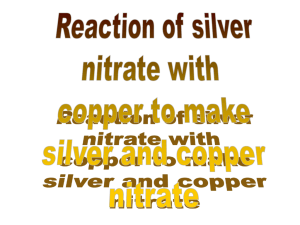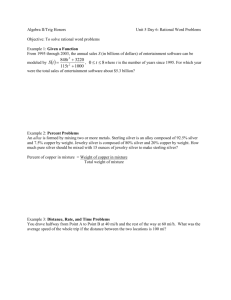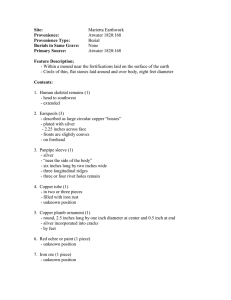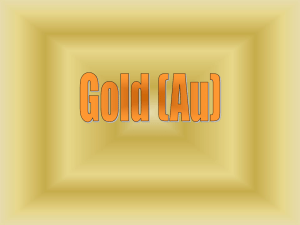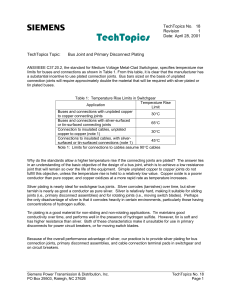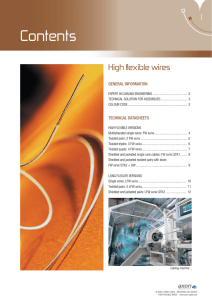Trade Name: Silver Plated Copper Wire Chemical Family: Silver
advertisement
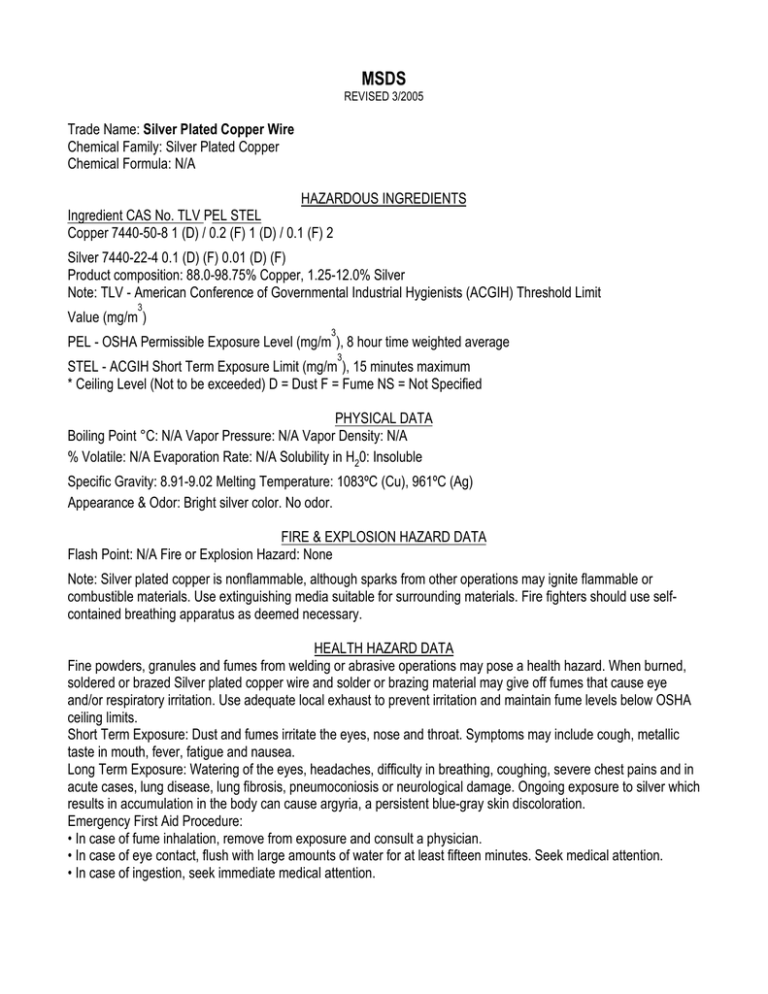
MSDS REVISED 3/2005 Trade Name: Silver Plated Copper Wire Chemical Family: Silver Plated Copper Chemical Formula: N/A HAZARDOUS INGREDIENTS Ingredient CAS No. TLV PEL STEL Copper 7440-50-8 1 (D) / 0.2 (F) 1 (D) / 0.1 (F) 2 Silver 7440-22-4 0.1 (D) (F) 0.01 (D) (F) Product composition: 88.0-98.75% Copper, 1.25-12.0% Silver Note: TLV - American Conference of Governmental Industrial Hygienists (ACGIH) Threshold Limit 3 Value (mg/m ) 3 PEL - OSHA Permissible Exposure Level (mg/m ), 8 hour time weighted average 3 STEL - ACGIH Short Term Exposure Limit (mg/m ), 15 minutes maximum * Ceiling Level (Not to be exceeded) D = Dust F = Fume NS = Not Specified PHYSICAL DATA Boiling Point °C: N/A Vapor Pressure: N/A Vapor Density: N/A % Volatile: N/A Evaporation Rate: N/A Solubility in H20: Insoluble Specific Gravity: 8.91-9.02 Melting Temperature: 1083ºC (Cu), 961ºC (Ag) Appearance & Odor: Bright silver color. No odor. FIRE & EXPLOSION HAZARD DATA Flash Point: N/A Fire or Explosion Hazard: None Note: Silver plated copper is nonflammable, although sparks from other operations may ignite flammable or combustible materials. Use extinguishing media suitable for surrounding materials. Fire fighters should use selfcontained breathing apparatus as deemed necessary. HEALTH HAZARD DATA Fine powders, granules and fumes from welding or abrasive operations may pose a health hazard. When burned, soldered or brazed Silver plated copper wire and solder or brazing material may give off fumes that cause eye and/or respiratory irritation. Use adequate local exhaust to prevent irritation and maintain fume levels below OSHA ceiling limits. Short Term Exposure: Dust and fumes irritate the eyes, nose and throat. Symptoms may include cough, metallic taste in mouth, fever, fatigue and nausea. Long Term Exposure: Watering of the eyes, headaches, difficulty in breathing, coughing, severe chest pains and in acute cases, lung disease, lung fibrosis, pneumoconiosis or neurological damage. Ongoing exposure to silver which results in accumulation in the body can cause argyria, a persistent blue-gray skin discoloration. Emergency First Aid Procedure: • In case of fume inhalation, remove from exposure and consult a physician. • In case of eye contact, flush with large amounts of water for at least fifteen minutes. Seek medical attention. • In case of ingestion, seek immediate medical attention. Carcinogenic assessment: Neither component of this material has been identified as a known or suspected carcinogen by NTP, IARC or OSHA. REACTIVITY DATA Stability: Stable. Hazardous polymerization will not occur. SPILL, LEAK, DISPOSAL PROCEDURES Scrap metal may have reclamation value. Where this is not practical, it may be disposed in accordance with state and federal regulations. In solid form, Silver plated copper poses no special clean up problems. If material is in powder or dust form, clean up should be conducted to minimize generation of airborne powder and dust and to avoid contamination of water. Depending on the quantity, spills or releases to the environment may require a report to the National Response Center at (800) 424-8802. SARA TITLE III SECTION 313 Copper compounds are subject to the reporting requirements of Section 313 of Title III of the Superfund Amendment and Reauthorization Act of 1986 and 40 CFR Part 372 of the Federal Register. Additional information can be obtained from the Emergency Planning and Community Right-To-Know Information Hot Line, US EPA, at (800) 535-0202. SPECIAL PROTECTION Wear safety glasses when risk of eye injury is present, particularly during machining, grinding, welding, powder handling, etc. Gloves and other protective equipment may be required during handling operations as appropriate to the circumstances of exposure. SPECIAL PRECAUTIONS When welding, melting, casting, grinding, sanding, polishing or otherwise abrading the surface of silver plated copper wire in a manner which generates finely divided particles, an exposure to copper and silver in excess of the occupational standard can occur. Use with adequate ventilation to meet listed exposure limits. Processes generating airborne particles must be air sampled to determine exposure levels. Where exposure data indicate, medical surveillance should be conducted. PACKAGING & LABELING REQUIREMENTS D.O.T. Shipping Name: Not regulated Hazard Class: NA MWS has attempted to provide current and accurate information in this data sheet, however MWS makes no representations regarding the accuracy or completeness of the information and assumes no liability for any loss, damage or injury of any kind which may arise out of the use or reliance on the information by any person. Contact person: Ken Goss at (818) 991-8553.
